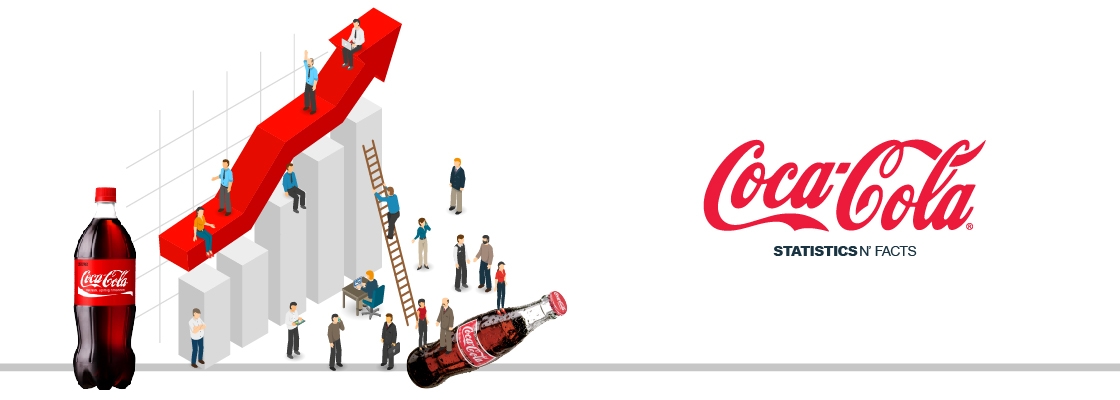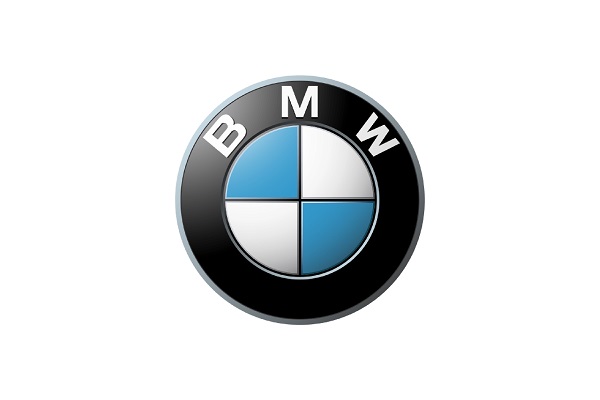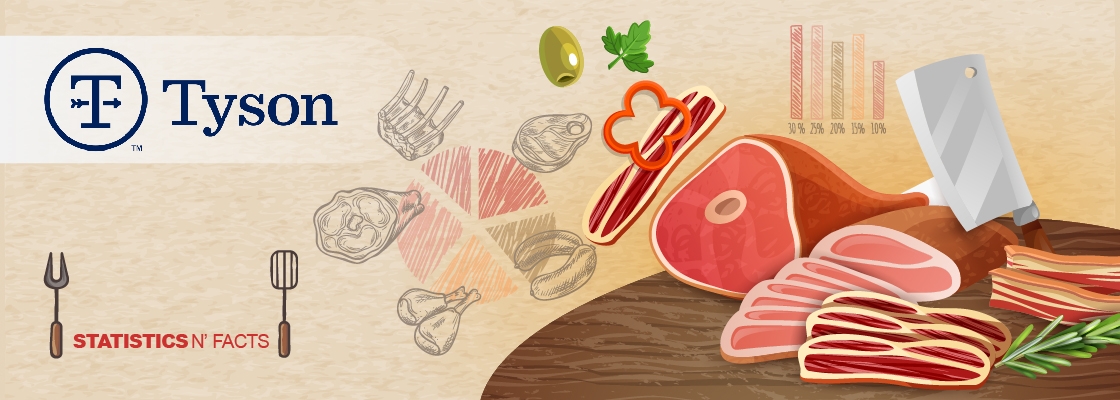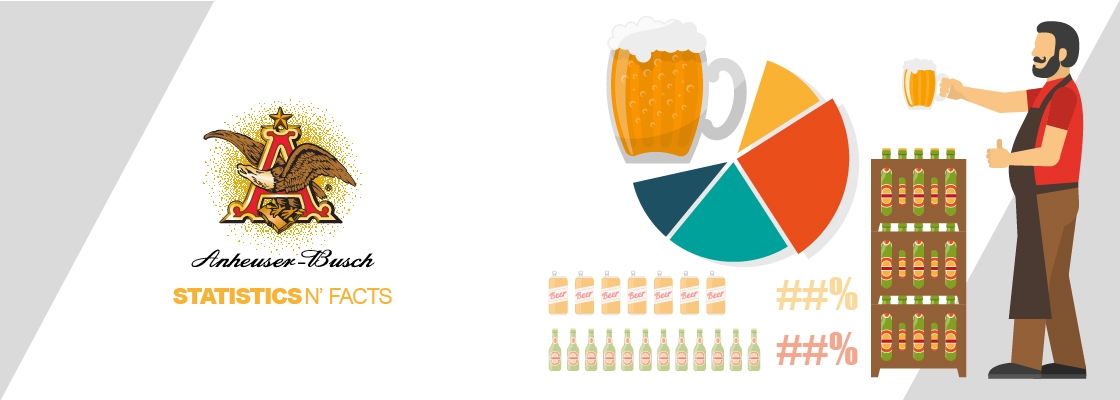Introduction
Coca-Cola is a widely recognised, sweetened carbonated soft drink produced by The Coca-Cola Company. This beverage enjoys global fame, being available in over 200 countries, and serves as the flagship product of a multinational corporation that markets numerous other brands, such as Fanta, Sprite, and Dasani.
Coca-Cola operates as a global beverage entity, with statistics highlighting its vast scale, including the distribution of over 1.9 billion drinks each day across more than 200 countries. The company boasts a portfolio exceeding 500 brands, which includes Diet Coke, Fanta, Sprite, Coca-Cola Zero, Vitamin Water, PowerAde, and Minute Maid, among others. It stands as the largest beverage manufacturer and distributor in the world. Established in 1886 from a single soda fountain in a drugstore, Coca-Cola has evolved into one of the largest corporations, with its brand recognised as one of the most valuable globally.
The remarkable growth of Coca-Cola can be credited to its unwavering commitment to product quality, successful marketing strategies, and strategic acquisitions. Additionally, the company has been linked to several major global events, including the Olympics and the FIFA World Cup.
Editor’s Choice
- Coca-Cola beverages are available in more than 200 countries and territories around the globe.
- Coca-Cola’s annual bottling volume worldwide surpasses 30 billion unit cases.
- Since the year 2000, Coca-Cola has maintained a strong position in the U.S. carbonated beverage market, holding a 42.8% market share.
- In 2023, the total assets amounted to USD 94.303 billion, indicating a 5.33% growth from 2022.
- The volume of unit cases increased by 2%, with India, China, and Brazil leading the growth.
- In 2023, Coca-Cola achieved sales of 33.3 billion drink cases, marking an increase from 32.7 billion in 2022.
- Coca-Cola holds a 40% share of the global non-alcoholic beverage market.
- During the same timeframe, users of coca-cola.com comprised 51.71% female and 48.29% male.
Historical Facts
- On May 8, 1886, Coca‑Cola was invented and served at Jacobs’ Pharmacy. During that year, nine drinks were sold each day.
- In 1887, Coca-Cola coupons were introduced as a promotional tool for Coca‑ The label “Coca‑Cola Syrup and Extract” was registered as a copyright with the U.S. Patent Office.
- In 1892, Asa Candler, who began acquiring The Coca‑Cola Company in 1888, completed the purchase and incorporated The Coca‑Cola Company as a corporation in Georgia.
- In 1898, the first building specifically constructed to house The Coca‑Cola Company was established.
- In 1899, Asa Candler transferred the rights to bottle Coca‑Cola across the majority of the United States to Benjamin F. Thomas and Joseph B. Whitehead, who were from Chattanooga, Tennessee, for the sum of $1.
- In 1904, the first advertisement for Coca‑Cola was published in national magazines. Annual sales of Coca‑Cola reached the milestone of 1 million gallons.
- In 1907, the Company initiated its long-standing partnership with athletes by launching a series of advertisements featuring prominent baseball players.
- In 1911, The Coca‑Cola Company’s annual advertising budget exceeded $1 million for the first time.
- In 1919, a group of investors led by Ernest Woodruff acquired the Coca‑Cola Company for $25 million.
- In 1935, Lettie Pate Evans became a member of the Board of Directors of The Coca‑Cola Company. She was the first woman to hold a position on the board of a major corporation, a role she maintained until 1953.
- In 1943, the U.S. government requested that Coca‑Cola be made accessible to the troops.
- During the war, 64 portable bottling plants were dispatched to Asia, Europe, and North Africa. Over 5 billion bottles of Coca‑Cola were distributed.
- In 1945, “Coke” was officially registered as a trademark of The Coca‑Cola Company.
- In 1960, The Coca‑Cola Company acquired The Minute Maid Corporation, thereby expanding its product line to include juices.
- In 1969, a new visual identity for the Coca-Cola system was launched, featuring a red-and-white color scheme and logo.
- In 1970, Coca‑Cola launched its first sports drink, Olympade, which was test-marketed in the United States.
- In 1971, Coca-Cola initially introduced it through a radio advertisement and subsequently produced it as a television commercial. “I’d Like to Buy the World a Coke” became an international sensation and remains one of the most beloved advertisements for Coca‑
- In 1985, the formula for Coca‑Cola was altered for the first time in 99 years. The product, commonly referred to as “New Coke,” sparked widespread consumer protests across the nation.
- In 1993, the well-known Coca‑Cola polar bears made their debut in the advertisement titled “Northern Lights.”
- In 2005, Coca‑Cola Zero, a zero-calorie cola, was launched.
- In 2011, it acquired the remaining shares in Honest Tea, having previously purchased a 40% stake in 2008 for $43 million.
- In 2017, The Coca-Cola Company acquired the Mexican sparkling water brand Topo Chico.
- In 2021, Coca-Cola introduced its Coffee variant in multiple markets, combining the traditional soda with coffee.
- In 2022, Coca-Cola ventured into the energy drink sector with Coca-Cola Energy, which is offered in numerous countries.
- In 2023, Coca-Cola adopted sophisticated AI and data analytics to enhance its supply chain and marketing approaches.
General Coca-Cola Statistics and Facts
- Coca-Cola beverages are available in more than 200 countries and territories around the globe.
- The Coca-Cola Company provides over 500 brands, which include sparkling beverages, sports drinks, water, milk, juices, plant-based drinks, teas, and coffees.
- On a global scale, approximately 1.9 billion servings of Coca-Cola beverages are consumed each day.
- Coca-Cola is committed to reducing its carbon footprint by 25% by the year 2030, as part of its comprehensive sustainability objectives.
- The company has initiated the “World Without Waste” program, which aims to collect and recycle a bottle or can for every one sold by 2030.
- Since 2015, Coca-Cola has successfully replenished 100% of the water utilized in its finished beverages.
- Coca-Cola has regularly engaged in share buybacks, repurchasing shares worth $500 million in the second quarter of 2022 alone.
- There are more than 16 million Coca-Cola vending machines in operation worldwide.
- Coca-Cola collaborates with a network of around 225 bottling partners globally.
- In 2022, Coca-Cola invested approximately $4 billion in global advertising.
- KO commands the largest market share in the global non-alcoholic beverage sector, accounting for over 40% of industry sales.
- The Coca-Cola brand is valued at roughly $80 billion, positioning it among the most valuable brands globally.
- Coca-Cola’s annual bottling volume worldwide surpasses 30 billion unit cases.
- Notable acquisitions by Coca-Cola include Costa Coffee, which was acquired in 2019 for $4.9billion, and Innocent Drinks.
- The company’s inaugural advertisement was published in the Atlanta Journal on May 29, 1886, marketing the beverage as a “Delicious and Refreshing Drink.”
- Coca-Cola has maintained a long-term partnership with McDonald’s, serving as its primary soft drink supplier since 1955.
- Coca-Cola’s diversity initiatives are robust, with women making up 31% of the company’s diversity training, global leadership and being an essential component of corporate culture.

Coca-Cola Growth Statistics
- Since the year 2000, Coca-Cola has maintained a strong position in the U.S. carbonated beverage market, holding a 42.8% market share.
- The average daily consumption of Coke products worldwide amounts to 1.7 billion servings.
- Over 3% of all beverages consumed globally today are produced by Coca-Cola.
- Coca-Cola caters to all customer demographics by providing at least one beverage in every category, which includes soy-based drinks, water, and energy drinks.
- The company generates such substantial revenue that its annual income surpasses that of 120 countries where Coca-Cola is available.
- $74 billion. This figure represents the estimated market value of Coca-Cola globally today, exceeding the combined value of its main competitors.
- In the previous year, soft drink revenues for Coca-Cola reached $28 billion.
- The total number of vending machines owned by Coca-Cola worldwide is 2.8 million.
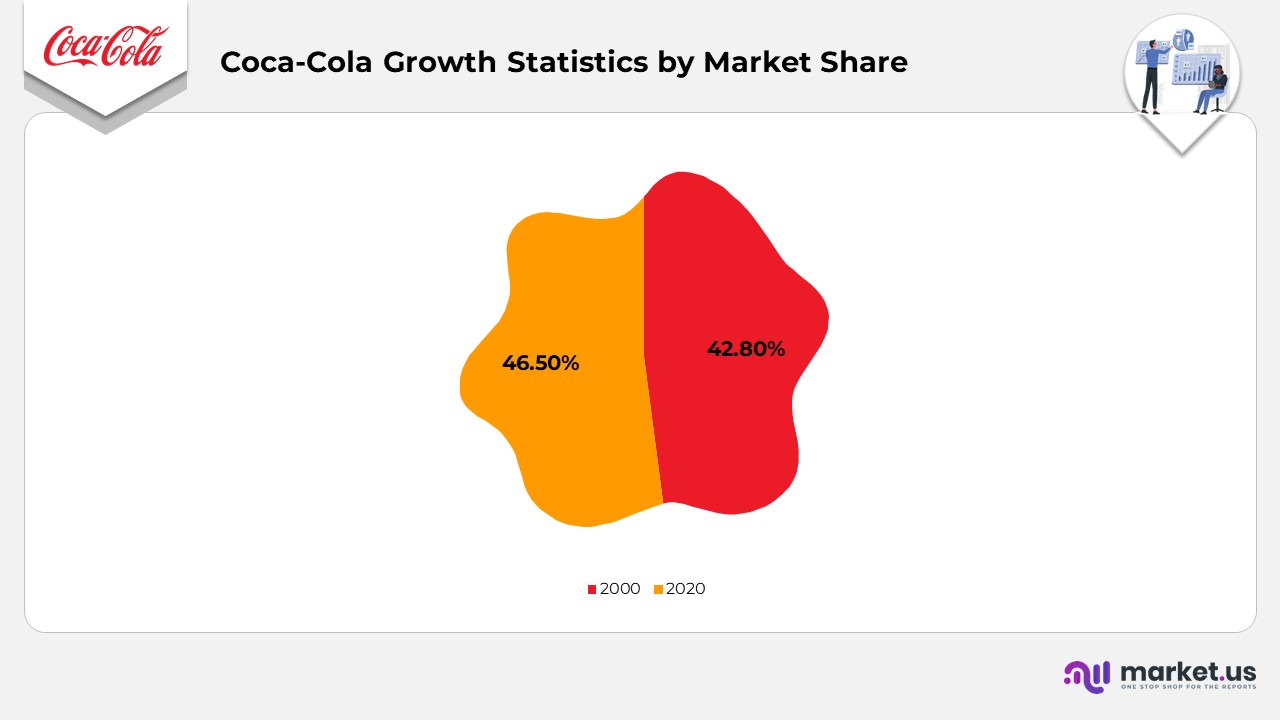
Coca-Cola Assets Statistics
- As of September 30, 2024, Coca-Cola’s total assets had increased to USD 100.566 billion, reflecting an 8.9% rise compared to the same timeframe in the previous year.
- In 2023, the total assets amounted to USD 94.303 billion, indicating a 5.33% growth from 2022.
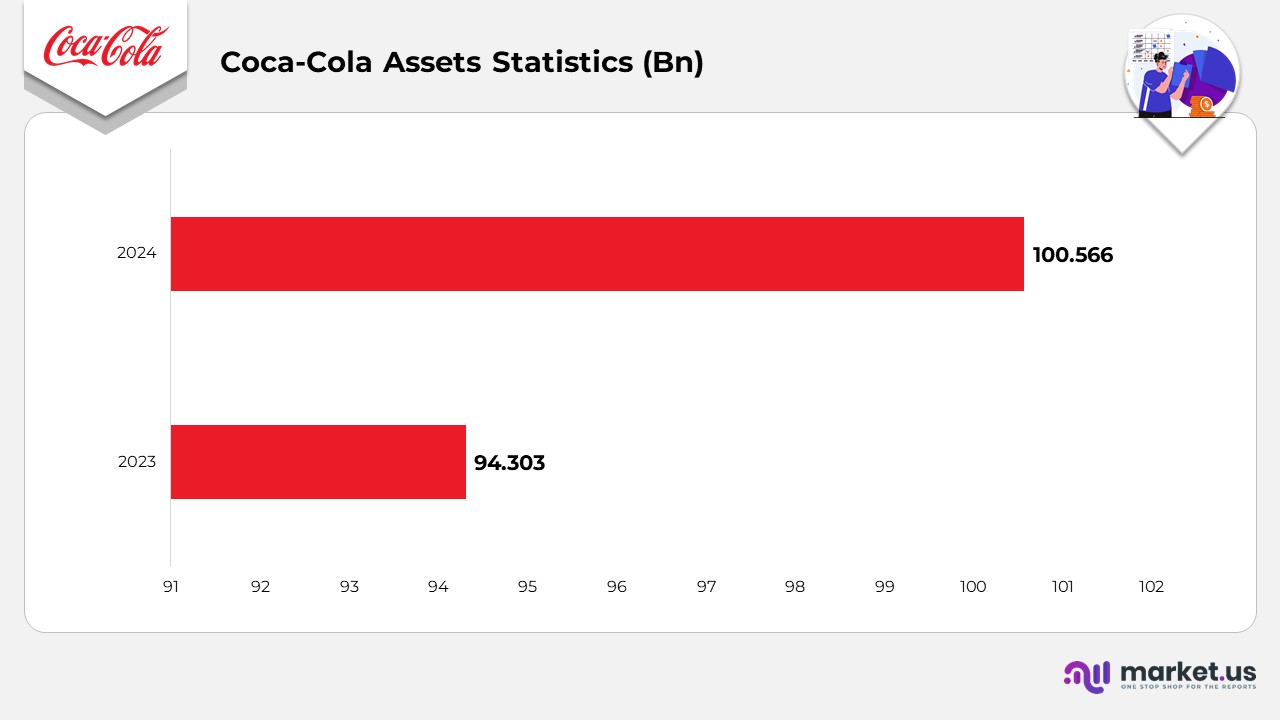
Coca-Cola Revenue Statistics
- A report analysis by Statista indicated that in 2023, Coca-Cola achieved net operating revenue and operating income of USD 45,754 million and USD 11,311 million, respectively.
- For the quarter ending September 30, 2024, Coca-Cola reported revenue of USD 11.854 billion, reflecting a decrease of 0.83% compared to the same quarter in the previous year.
- The company generated USD 47.06 billion over the twelve months ending on September 30, 2024, marking a 2.97% increase from the prior year.
Coca-Cola Geographical Growth Statistics
- The volume of unit cases increased by 2%, with India, China, and Brazil leading the growth.
- Sparkling soft drinks also saw a growth of 2%.
- The trademark Coca‑Cola experienced a growth of 1%, mainly fueled by increases in Europe, the Middle East, Africa, and the Asia Pacific region.
- Sparkling flavours grew by 2%, primarily due to growth in the Asia Pacific region.
- Juice, value-added dairy, and plant-based beverages rose by 1%, largely driven by growth in Asia Pacific.
- Water, sports drinks, coffee, and tea experienced a growth of 2%.
- Water specifically grew by 3%, propelled by growth in Asia Pacific, Latin America, and Europe, the Middle East, and Africa.
- However, sports drinks saw a decline of 1%, mainly due to decreases in Latin America and Asia Pacific.
- Coffee faced a decline of 2%, primarily attributed to reductions in Asia Pacific, the Middle East, Africa, and Europe.
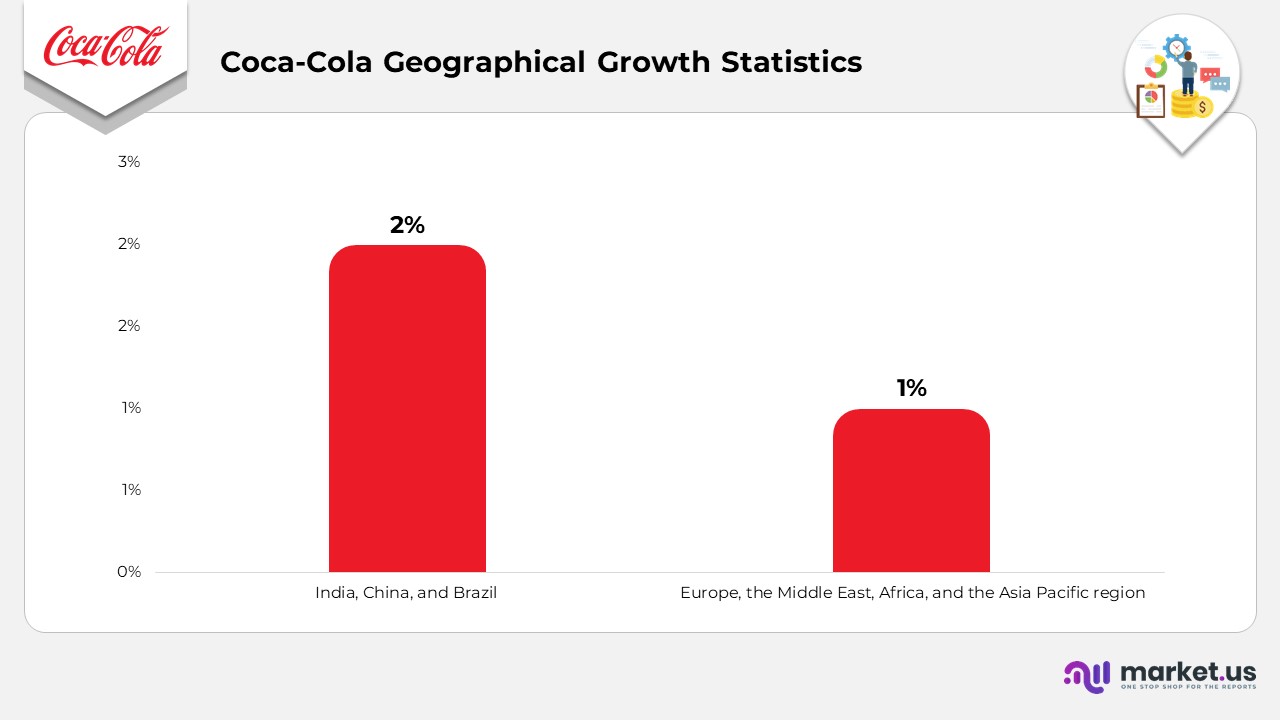
Coca-Cola Regional Statistics
- In the third quarter of 2024, there was a 12% increase in revenue within the North American region, while operating income rose by 10%.
- Coca-Cola Statistics indicated that in 2023, North America accounted for approximately 37% of the total revenue generated by the company.
- Following North America, Europe, the Middle East, and Africa contributed 16.2%, Latin America contributed 12.7%, and Asia Pacific contributed 10.3% to the revenue share.
- At the same time, the revenue share from bottling investments stood at 17.2%, with global ventures at 6.7% and corporate at 0.3%.
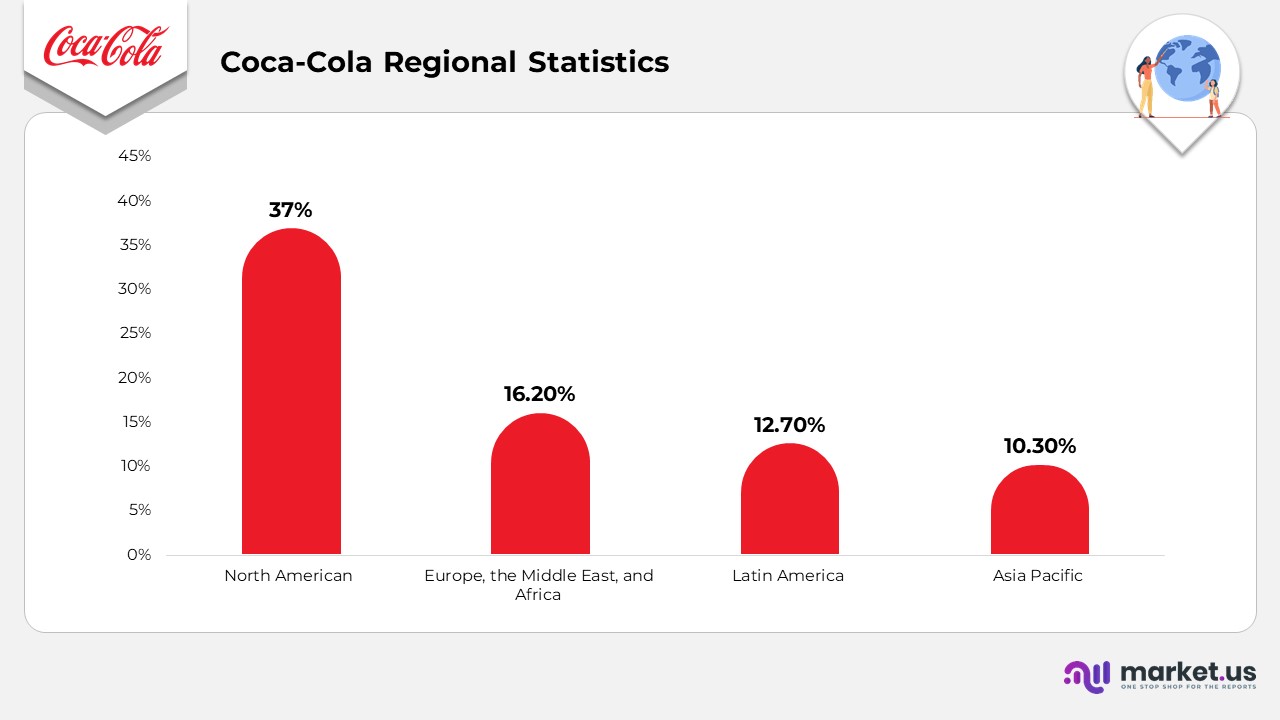
Soft Drink Brands Statistics
- The data for 2024 indicates that Coca-Cola will maintain its position as the leading soft drink brand globally, with a valuation of USD 98,716 million.
- Additionally, the valuations of other soft drink brands include:
- Gatorade at USD 6,294 million
- Mengnlu at USD 6,299 million
- Sprite at USD 6,857 million
- Fanta at USD 7,624 million
- Diet Coke at USD 7,737 million
- Monster at USD 8,450 million
- Yill at USD 10,208 million
- Nescafe at USD 10,457 million
- Nespresso at USD 11,439 million
- Pepsi at USD 17,689 million
- Nongfu Spring at USD 19,968 million
- Red Bull at USD 22,150 million
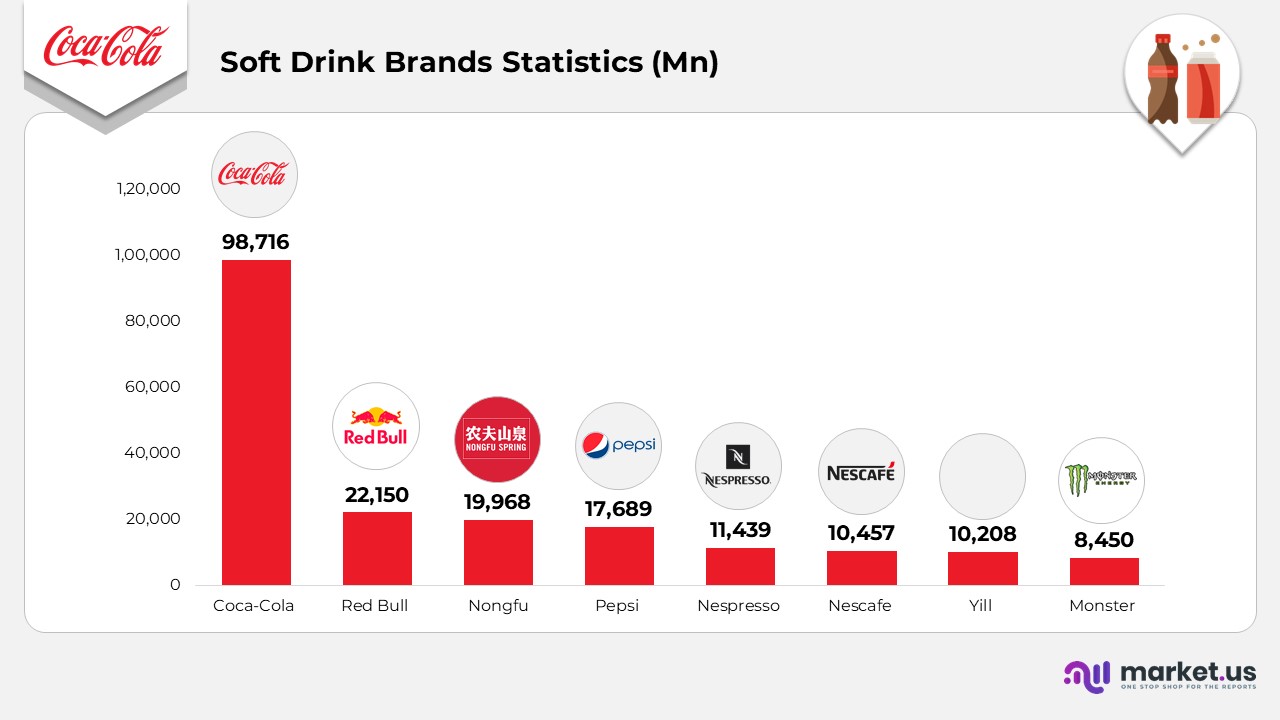
Coca-Cola Sales Statistics
- In 2023, Coca-Cola achieved sales of 33.3 billion drink cases, marking an increase from 32.7 billion in 2022.
- According to Coca-Cola’s data, in Q1 2024, the unit case volume rose by 1%, with significant growth observed in Brazil, the Philippines, and Nigeria.
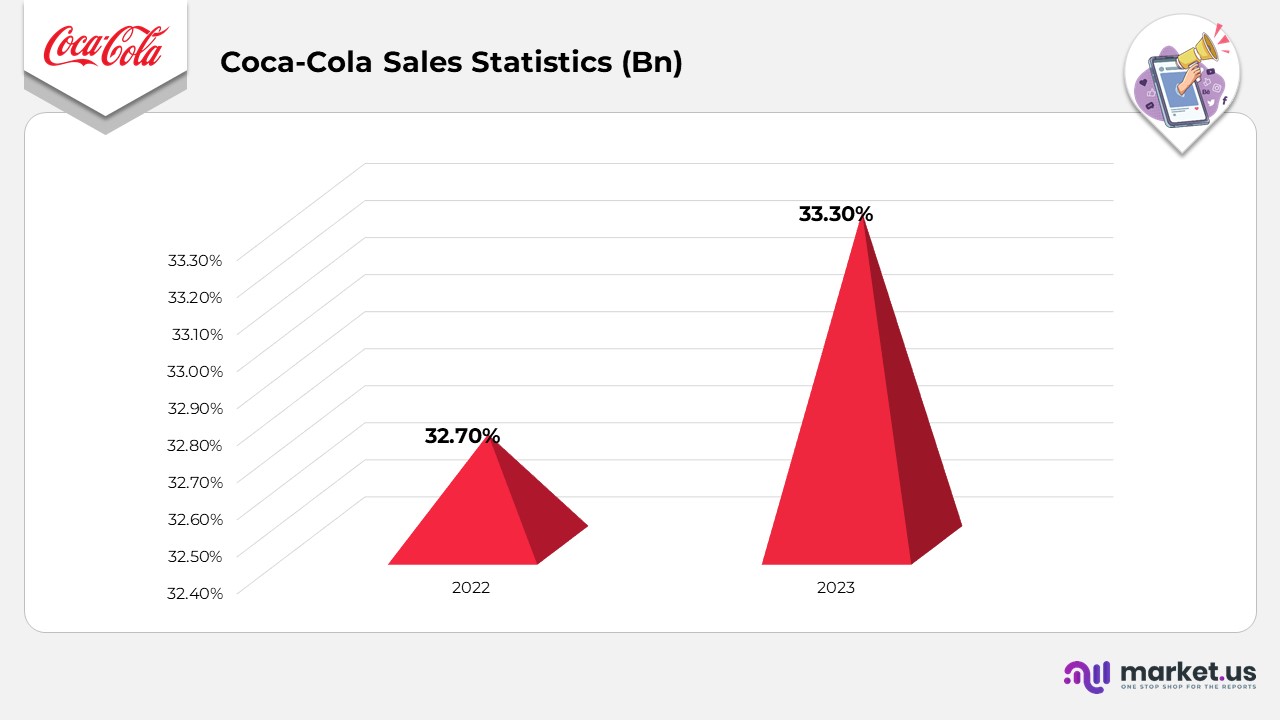
Coca-Cola Competitors Market Share
- Coca-Cola holds a 40% share of the global non-alcoholic beverage market.
- PepsiCo possesses a 30% share of the global non-alcoholic beverage market.
- Nestlé commands a 10% share of the global bottled water market.
- Keurig Dr Pepper has a 10% share in the North American beverage market.
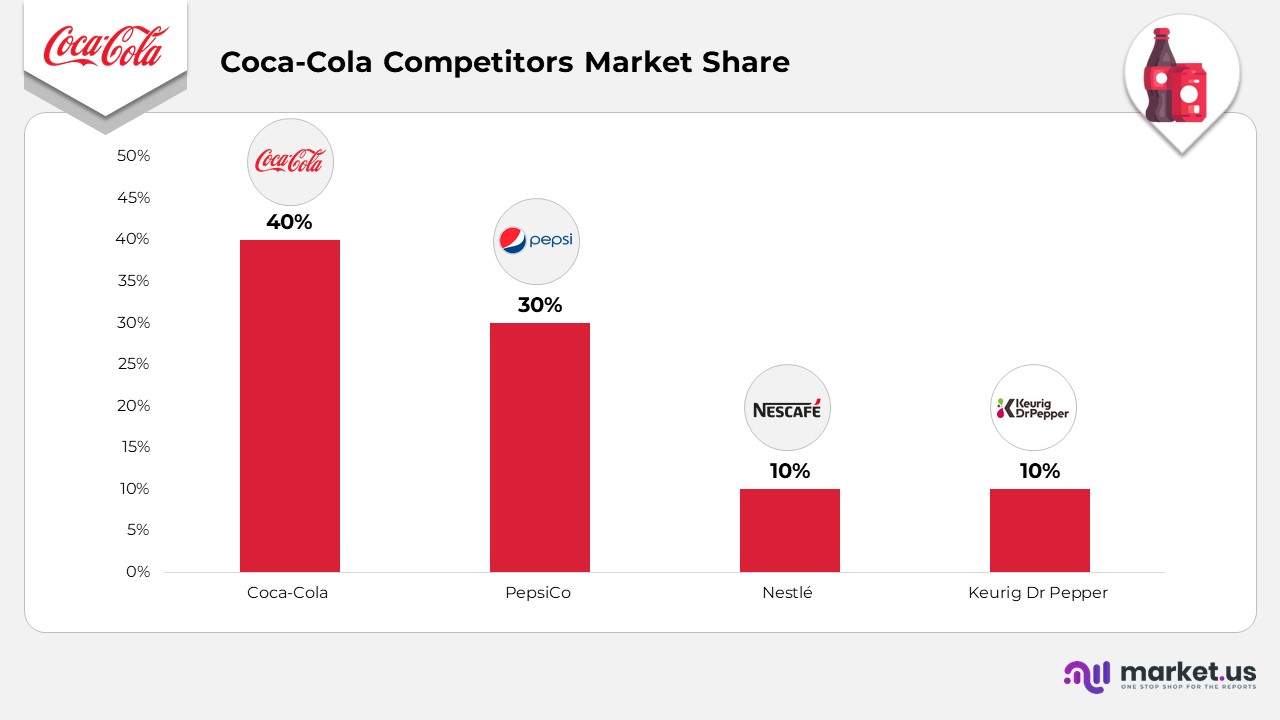
List of Coca-Cola Shareholders
- Berkshire Hathaway (9.3%)
- The Vanguard Group (8.6%)
- BlackRock (5.6%)
- State Street Corporation (3.9%)
- Geode Capital Management (2.1%)
- Fidelity Investments (1.9%)
- Eaton Vance (1.9%)
- JP Morgan Investment Management (1.5%)
- Charles Schwab Corporation (1.5%)
- BlackRock Life (1.3%), and others (62.4%).
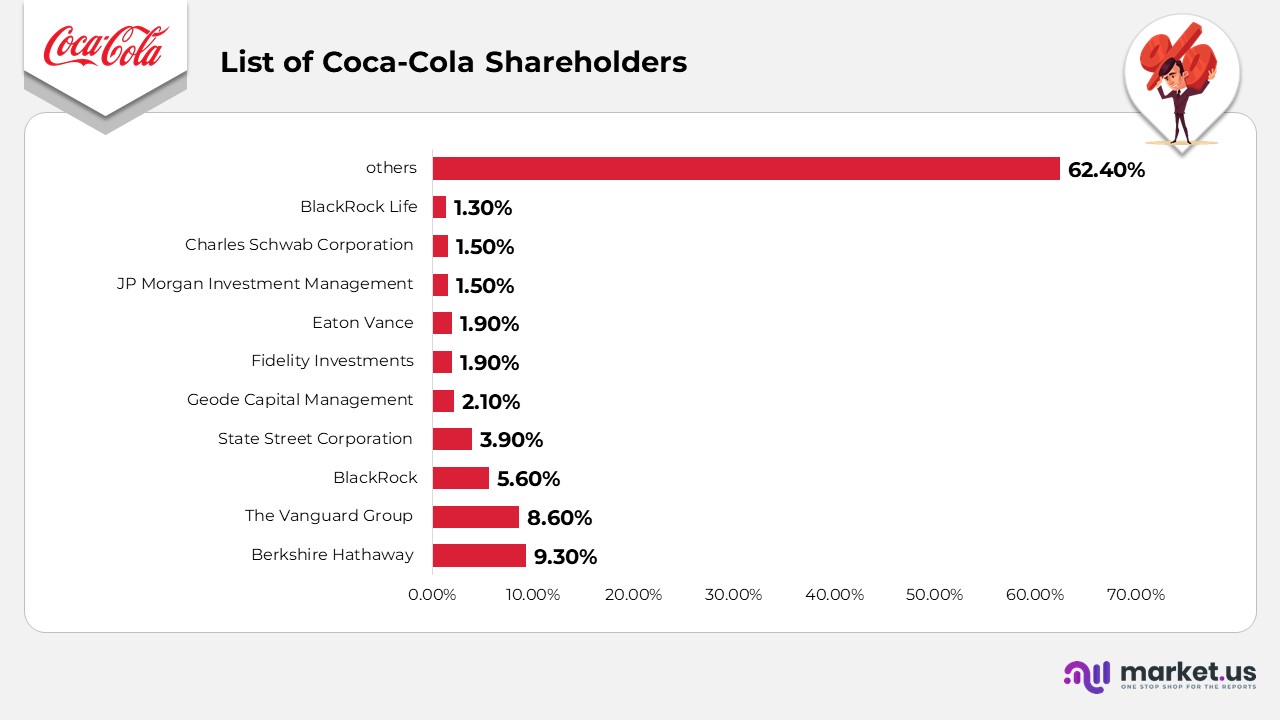
Coca-Cola Collaboration Statistics
- In April 2024, Coca-Cola established a five-year strategic alliance with Microsoft, committing USD 1.1 billion to Microsoft Cloud and generative AI.
- In September 2024, Coca-Cola and Oreo introduced limited-edition products, which included Oreo Coca-Cola and Coca-Cola Oreo Zero Sugar flavored cookies.
- As a Worldwide Olympic Partner, during the 2024 Summer Olympics in Paris, 23% of global respondents linked the brand to the event.
- Coca-Cola collaborated with Bacardi to launch a ready-to-drink (RTD) cocktail named “Bacardi Mixed with Coca-Cola.”
- Throughout the 2024 holiday season, Coca-Cola worked with local organisations in Spain to provide over 10,000 meals to families in need across 15 cities.
- In November 2024, Coca-Cola joined forces with the Southeast Naturalists Association and the Murcia City Council to plant over 100 native trees.
Coca-Cola Users by Demographics
- During the same timeframe, users of coca-cola.com comprised 51.71% female and 48.29% male.
- Among the users of the Coca-Cola website, 26.24% fall within the age range of 25 to 34.
- In contrast, 20.77% are aged between 35 and 44 years, while 17.01% belong to the 18 to 24 age group.
- Furthermore, on coca-cola.com, only 16.44% of the users are aged between 45 and 54, followed by 12.32% who are in the 55 to 64 age bracket, and approximately 7.23% who are 65 years or older.

Coca-Cola Usage Statistics
- In today’s world, the typical individual consumes at least 1 Coca-Cola product every four days.
- This is the average number of servings that Americans are expected to consume of Coke products in the upcoming year. 63% of these servings will consist of Coca-Cola Classic.
- Americans add 10.8 pounds of sugar to their diet annually due to their sugar consumption. This translates to 1.7 million pounds of sugar consumed each year as a result of Coke.
- The average Mexican is projected to drink 728 servings of Coca-Cola products in the next year.
- Conversely, the average Indian consumer [from India, not a Native American/First Nations individual] will only consume 9 servings.
- Metal suppliers also represent a demographic for Coca-Cola. The brand utilises 300,000 tons of aluminium to manufacture cans for its beverages.
- Health-conscious consumers are another demographic for Coke, as the company offers over 1,000 different varieties of juice drinks.
Coca-Cola Traffic by Social Media
- As per Coca-Cola Statistics, Facebook was the leading platform for social media referrals, capturing a 51.23% share of the overall traffic.
- YouTube accounted for 15.75%, while Reddit contributed 10.55% of the traffic directed to coca-cola.com.
- Instagram and Twitter represented shares of 8.81% and 4.05%, respectively, for the website.
- Other social media platforms utilized by Coca-Cola.com constituted approximately 9.62% of its total share.
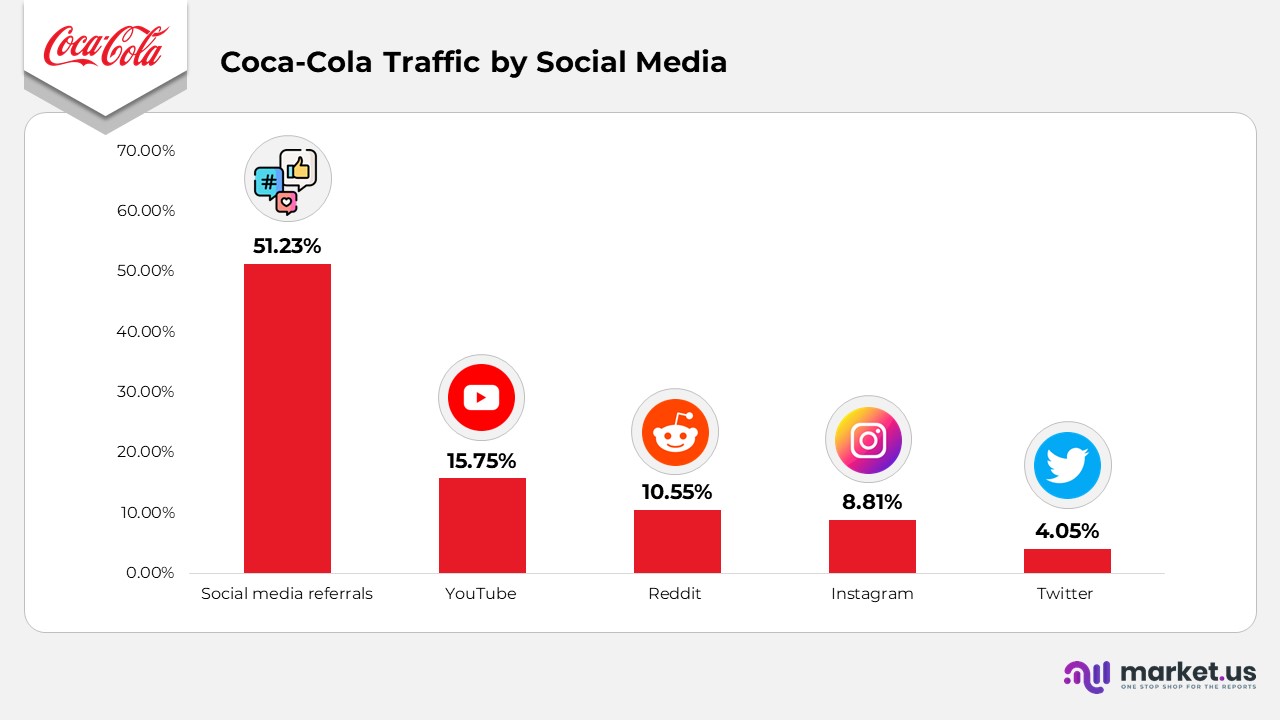
Coca-Cola Employee Statistics
- As of December 31, 2024 and 2023, Coca-Cola Company had approximately 69,700 and 79,100 employees, respectively.
- Approximately 8,900 and 9,000 employees, respectively, were located in the United States.
- The decrease in the total number of employees was primarily due to the 2024 refranchising activity.
- As of December 31, 2024, approximately 400 employees in North America were covered by collective bargaining agreements.
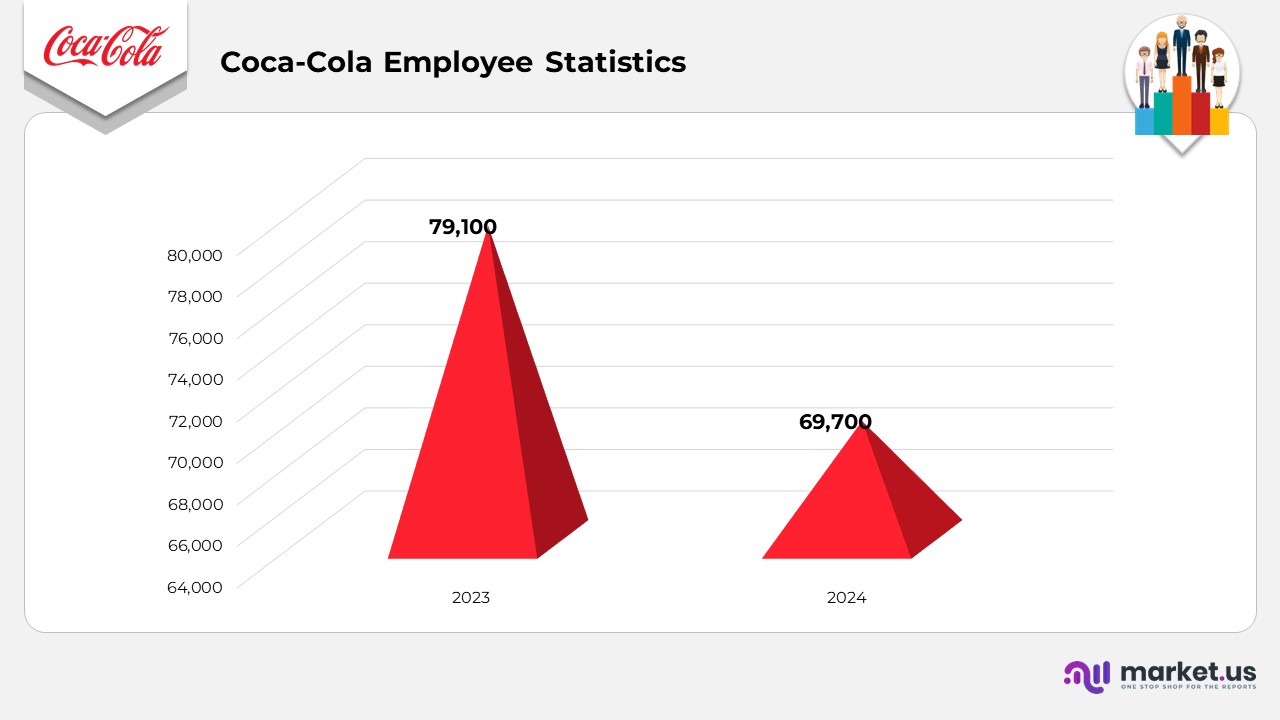
Coca-Cola Fun Facts
- The term “Coca-Cola” is derived from its initial components, coca leaves and kola nuts.
- More than 10,000 Coca-Cola soft drinks are consumed worldwide every second.
- Coca-Cola was the pioneer in introducing bottles made from recycled materials.
- Originally, the iconic Coca-Cola bottle was designed to resemble a cocoa bean.
- In 1985, Coca-Cola made history as the first soft drink to travel to space.
- Mexicans are the highest consumers of Coke, with individuals in the country consuming 745 Coke beverages annually.
- Following the word “OK”, “Coca-Cola” ranks as the second most recognised phrase globally.
- Coca-Cola boasts a diverse product range that includes over 3,500 beverages and 500 brands.
- Coca-Cola is not available for sale in Cuba and North Korea.
- Coca-Cola has set a goal to collect and recycle one bottle for every drink sold by the year 2030.
Recent Developments
- As of the beginning of 2024, approximately 65% of Coca-Cola’s overall revenues were generated from its international business segments.
- In the first quarter of 2025, the company’s net revenues increased by 6% to reach $45.8 billion. This growth was fueled by price/mix improvements and organic revenue expansion, although it was somewhat counterbalanced by rising input costs and marketing expenditures.
- During the first quarter of 2025, earnings per share (EPS) rose by 5% to $0.77, which accounted for a 9-point currency headwind. The comparable EPS (non-GAAP) saw a 1% increase to $0.73, reflecting a 5-point currency headwind.
Coca-Cola Future Predictions
- Coca-Cola anticipates achieving organic revenue (non-GAAP) growth of 5% to 6% by the years 2025-2026.
- By 2026, the corporation projects a currency headwind of 2% to 3% based on current exchange rates, factoring in the effects of hedged positions, for comparable net revenues.
- Coca-Cola also expects to realise comparable currency-neutral EPS (non-GAAP) growth of 7% to 9%.
- In 2019, Coca-Cola acquired Costa Coffee for $5.1 billion, primarily as a strategic investment in the anticipated growth of the coffee market, which is projected to grow at an annual rate of 4.7% until 2030.
- Coca-Cola is projected to increase its annual per share dividend to $2.562 by the year 2030.
Conclusion
Coca-Cola is a worldwide beverage leader with an extensive presence, distributing over 1.9 billion drinks each day in more than 200 nations and employing 700,000 individuals as of 2023. Its brand value is substantial, and its financial results have been robust, showcasing significant revenue and a considerable market capitalisation, although financial metrics may vary from year to year.
The company continues to expand by emphasising innovation in its product lines, distribution methods, and sustainability initiatives. Coca-Cola’s lasting brand equity and creative marketing strategies foster strong cultural ties with consumers, solidifying its position as a market leader. This, along with solid financial performance and reliable dividends, positions Coca-Cola (KO) as an attractive option for investors.


